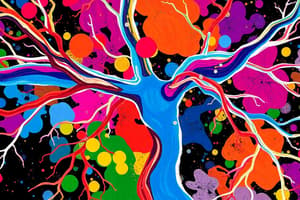Podcast
Questions and Answers
Visual information is processed in the ______ lobe
Visual information is processed in the ______ lobe
occipital
The CNS controls the muscles and organs of the body, allowing us to perform complex ______
The CNS controls the muscles and organs of the body, allowing us to perform complex ______
movements
The brainstem plays a central role in regulating vital ______
The brainstem plays a central role in regulating vital ______
functions
The CNS communicates with the rest of the body through ______ pathways
The CNS communicates with the rest of the body through ______ pathways
Neurons can be categorized into three types: sensory neurons, interneurons, and ______ neurons
Neurons can be categorized into three types: sensory neurons, interneurons, and ______ neurons
The cerebral cortex plays a central role in tasks like reasoning, problem-solving, and emotional ______
The cerebral cortex plays a central role in tasks like reasoning, problem-solving, and emotional ______
The central nervous system (CNS) is composed of two primary parts: the ______ and the spinal cord
The central nervous system (CNS) is composed of two primary parts: the ______ and the spinal cord
The brain plays a central role in processing information, making decisions, and controlling ______ actions
The brain plays a central role in processing information, making decisions, and controlling ______ actions
The cerebral cortex handles higher cognitive functions, the cerebellum is responsible for motor control, and the brainstem regulates vital functions like breathing and ______
The cerebral cortex handles higher cognitive functions, the cerebellum is responsible for motor control, and the brainstem regulates vital functions like breathing and ______
The spinal cord is responsible for transmitting signals between the brain and the rest of the body. It runs down the center of the ______ column
The spinal cord is responsible for transmitting signals between the brain and the rest of the body. It runs down the center of the ______ column
The cervical region of the spinal cord controls the ______
The cervical region of the spinal cord controls the ______
The lumbar region of the spinal cord controls the ______
The lumbar region of the spinal cord controls the ______
Flashcards are hidden until you start studying
Study Notes
Exploring the Nervous System: A Deeper Dive into the Central Nervous System
The nervous system is a complex and intricate network of cells that allows us to sense, think, and move. At its core, we find the central nervous system (CNS), a hub of communication and control that connects and coordinates the activities of our body.
Components of the Central Nervous System
The CNS is composed of two primary parts:
-
Brain: The brain is encased within the skull and is an incredibly intricate organ. It plays a central role in processing information, making decisions, and controlling voluntary actions. The brain is divided into regions responsible for specific tasks, including the cerebral cortex (which handles higher cognitive functions), the cerebellum (responsible for motor control), and the brainstem (regulating vital functions like breathing and consciousness).
-
Spinal cord: The spinal cord is a long, cylindrical structure that runs down the center of the vertebral column. It is responsible for transmitting signals between the brain and the rest of the body. The spinal cord is divided into regions, each responsible for particular tasks, like the cervical region (which controls the arms) and the lumbar region (which controls the legs).
Function of the Central Nervous System
The CNS is responsible for numerous essential functions, including:
-
Processing sensory information: The CNS receives information from sensory receptors throughout the body and processes it in various ways. For example, visual information is processed in the occipital lobe, auditory information in the temporal lobe, and tactile information in the parietal lobe.
-
Decision making and higher cognitive functions: The CNS is responsible for complex tasks like reasoning, problem-solving, and emotional regulation. The brain's cerebral cortex plays a central role in these functions.
-
Motor control: The CNS controls the muscles and organs of the body, allowing us to perform complex movements. The cerebral cortex and cerebellum play essential roles in motor control.
-
Regulating vital functions: The CNS regulates numerous vital functions, such as breathing, circulation, and consciousness. The brainstem plays a central role in these functions.
Communication Pathways
The CNS communicates with the rest of the body through two primary types of communication pathways:
-
Afferent (sensory) pathways: These carry sensory information from the body to the CNS.
-
Efferent (motor) pathways: These carry motor signals from the CNS to the muscles and organs of the body.
Neurons and their Roles
The CNS is composed of specialized cells called neurons, which play essential roles in communication and processing information. Neurons can be categorized into three types:
-
Sensory neurons: These neurons transmit sensory information from sensory receptors to the CNS.
-
Interneurons: These neurons are located within the CNS and play essential roles in processing and transmitting information.
-
Motor neurons: These neurons transmit motor signals from the CNS to muscles and organs.
In summary, the central nervous system is a complex and intricate network of cells that plays essential roles in processing information, making decisions, and controlling our movements. The CNS is composed of two primary components: the brain and the spinal cord. The CNS communicates with the rest of the body through afferent (sensory) and efferent (motor) pathways, while neurons play essential roles in communication and information processing.
Studying That Suits You
Use AI to generate personalized quizzes and flashcards to suit your learning preferences.




